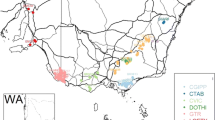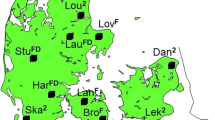Abstract
Under a changing climate, tree improvement programs should revise breeding zones to improve climate change adaptation and program efficiency once information about adaptive capacity of breeding populations and genotype × environment (G × E) interaction becomes available. In this study, we evaluated the adaptation and growth, as well as G × E interactions, shown by white spruce (Picea glauca (Moench) Voss) open-pollinated (OP) families across two adjacent breeding zones (i.e., the BZ3300 and BZ4300, respectively) in northwestern Ontario using progeny test data, including 80 OP families (40 from each) that were cross-tested between the breeding zones. Results showed that the OP families from the southerly BZ4300 breeding zone averaged higher survival and significantly greater mean tree height growth than the local OP families in the more northern BZ3300 breeding zone at tree age of 14 years, with no notable difference in frost damage. Estimates of type-B genetic correlation from pairwise tests or combined-test analyses were almost all greater than 0.7, suggesting weak G × E interactions. Greater variation among families and higher heritability estimates in tree height were observed for families from the BZ3300 breeding zone or when families from the two breeding zones were combined. The weak G × E interactions, in addition to better survival and growth of the southerly families in the more northern breeding zone, suggested benefits from deploying seed from current seed orchard in the BZ4300 breeding zone to the BZ3300 breeding zone and merging the two breeding zones when starting the second generation breeding to increase tree improvement efficiency and likely higher genetic gain under future climate.



Similar content being viewed by others
References
Burdon RD (1977) Genetic correlation as a concept for studying genotype–environment interaction in forest tree breeding. Silvae Genet 26:168–175
Campbell RK (1979) Genecology of Douglas-fir in a watershed in the Oregon Cascades. Ecology 60:1036–1050
Chen ZQ, Karlsson B, Wu HX (2017) Patterns of additive genotype-by-environment interaction in tree height of Norway spruce in southern and central Sweden. Tree Genet Genomes 13:25. https://doi.org/10.1007/s11295-017-1103-6
Cornelius J (1994) Heritabilities and additive genetic coefficients of variation in forest trees. Can J For Res 24:372–379
Finlay KW, Wilkinson GN (1963) The analysis of adaptation in a plant-breeding programme. Aust J Agric Res 14:742–754
Gilmoure AR, Gogel BJ, Cullis BR, Welham SJ, Thomson R (2015) ASReml user guide. Release 4.1. Structural specification. VSN International Ltd., Hemel Hempstead
Gray LK, Hamann A, John S, Rweyongeza D, Barnhardt L, Thomas BR (2016) Climate change risk management in tree improvement programs: selection and movement of genotypes. Tree Genet Genomes 12:23. https://doi.org/10.1007/s11295-016-0983-1
Hills GA (1960) Regional site research. For Chron 36:401–423
Intergovernmental Panel on Climate Change (IPCC) (2014) Climate Change 2014: synthesis report of Working Groups I, II and III to the fifth assessment report of the Intergovernmental Panel on Climate Change Core Writing team, Pachauri RK, Meyers LA (eds), IPCC, Geneva, Switzerland, 151 p
Johnson GR (1997) Site-to-site correlations and their implications in breeding zone size and optimum number of progeny test sites for coastal Douglas-fir. Silvae Genet 46:280–285
Johnson R (1998) Breeding design considerations for coastal Douglas-fir. USDA For Serv Gen Tech Rep:PNW-GTR-411
Johnson GR, Sorensen FC, St Clair JB, Cronn RC (2004) Pacific Northwest forest tree seed zones: a template for native plants? Native Plants J 5:131–140
Kiss GK, Yeh FC (1988) Heritability estimates for height for young interior spruce in British Columbia. Can J For Res 18:158–162
Li P, Corriveau A, Bousquet J (1993) Genetic variation in juvenile growth and phenology in a white spruce provenance progeny test. Silvae Genet 42:52–60
Li P, Beaulieu J, Bousquet J (1997) Genetic structure and patterns of genetic variation among populations in eastern white spruce (Picea glauca). Can J For Res 27:189–198
Lu P, Charrette P (2008) Genetic parameter estimates for growth traits of black spruce in northwestern Ontario. Can J For Res 38:2994–3001
Lu P, White TL (2004) Determining test and block numbers in consideration of progeny testing quality and cost: an example of half-sib families with RCB design and single-tree plots. For Genet 11:29–44
Lu P, Parker WH, Cherry M, Colombo S, Parker WC, Man RZ, Roubal N (2014) Survival and growth patterns of white spruce (Picea glauca [Moench] Voss) rangewide provenances and their implications for climate change adaptation. Ecol Evol 4:2360–2373
McKenney DW, Pedlar JH, Rood RB, Price D (2011) Revisiting projected shifts in the climate envelopes of North American trees using updated general circulation models. Glob Change Biol 17:2720–2730
Nienstaedt H, Riemenschneider DE (1985) Changes in heritability estimates with age and site in white spruce, Picea glauca (Moench) Voss. Silvae Genet 34:34–41
O’Neill GA, Aitken SN (2004) Area-based breeding zones to minimize maladaptation. Can J For Res 34:695–704
Ontario Ministry of Natural Resources [OMNR] (1987) Tree improvement master plan for Ontario. Queen’s Printer for Ontario, Toronto, p 81
Ontario Ministry of Natural Resources [OMNR] (2006) State of the forest report 2006. OMNR, Toronto, p 153
Rehfeldt GE (1995) Genetic variation, climate models and the ecological genetics of Larix occidentalis. For Ecol Manag 78:21–37
Rowe JS (1962) Soil, site and land classification. For Chron 38:420–432
Rweyongeza DM, Yang RC, Dhir NK, Barnhardt LK, Hansen C (2007) Genetic variation and climatic impacts on survival and growth of white spruce in Alberta, Canada. Silvae Genet 56:117–127
Saxton AM (2004) Genetic analysis of complex traits using SAS®. SAS Institute, Cary
Shelbourne CJA (1972) Genotype–environment interaction: its study and its implications in forest tree improvement. In: Proceedings of the joint symposia for the advancement of forest tree breeding of the genetics subject group, IUFRO, and Section 5, Forest Trees, SABRAO. Government Forest Experiment Station of Japan, Tokyo, pp 1–28
St. Clair JB, Mandel NL, Vance-Boland KW (2005) Genecology of Douglas fir in western Oregon and Washington. Ann Bot 96:1199–1214
Stonecypher RW, Piesch RF, Helland GG, Chapman JG, Reno HJ (1996) Results from genetic tests of selected parents of Douglas-fir (Pseudotsuga menziesii [Mirb.] Franco) in an applied tree improvement program. For Sci 42:1–35
Superior-Woods Tree Improvement Association (SWTIA) (2016) Analysis on the Dryden 4300 white spruce breeding zone family tests. Superior-Woods Tree Improvement Association report, Thunder Bay, p 39
SWTIA (2017) Analysis on the Red Lake 3300 white spruce breeding zone tests. Superior-Woods Tree Improvement Association report, Thunder Bay, p 37
Thomson AM, Crowe KA, Parker WH (2010) Optimal white spruce breeding zones for Ontario under current and future climates. Can J For Res 40:1576–1587
Wang T, Hamann A, Yanchuk A, O’Neill GA, Aitken SN (2006) Use of response functions in selecting lodgepole pine populations for future climates. Glob Change Biol 12:2404–2416. https://doi.org/10.1111/j.1365-2486.2006.01271.x
Weng YH, Tosh KJ, Park YS, Fullarton MS (2007) Age-related trends in genetic parameters for jack pine and their implications for early selection. Silvae Genet 56:242–252
White TL, Adams WT, Neale DB (2007) Forest genetics. CABI, Cambridge
Xie CY (2003) Genotype by environment interaction and its implications for genetic improvement of interior spruce in British Columbia. Can J For Res 33:1635–1643
Yeh FC, Rasmussen S (1985) Heritability of height growth in 10-year-old Sitka spruce. Can J Gen Cyt 27:729–734
Acknowledgements
We thank Janet Lane with the Domtar for assistance with trial establishment; and Holly Aggas with the Domtar, Karen Carpenter with the Dryden Forest Management Co. Ltd and Robert Partridge with the Red Lake Forest Management Co. for assistance with trial maintenance and measurement. The Ontario Living Legacy Trust (OLLT) funded trial establishment and the Ontario Forestry Futures Trust (OFFT) funded trial measurements.
Author information
Authors and Affiliations
Corresponding author
Rights and permissions
About this article
Cite this article
Weng, Y., Charrette, P. & Lu, P. Re-examining breeding zones of white spruce in northwestern Ontario, Canada. New Forests 50, 845–858 (2019). https://doi.org/10.1007/s11056-018-9692-y
Received:
Accepted:
Published:
Issue Date:
DOI: https://doi.org/10.1007/s11056-018-9692-y




